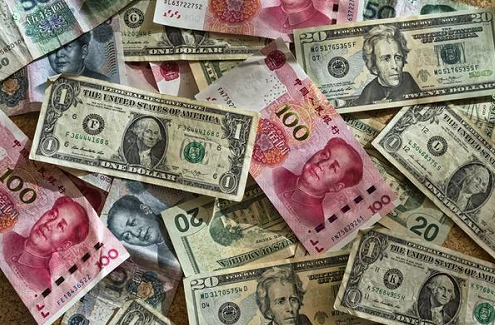国际贸易人民币结算进程加速

目前,越来越多的央行把目光投向人民币,以使外汇储备更加多元化。
国际货币基金组织(IMF)日前发布的官方外汇储备货币构成(COFER)数据显示,今年第一季度,人民币在COFER中的占比升至2.88%,位居全球第五,创下了IMF自2016年开始公布人民币储备资产以来的最高水平。
景顺最新发布的全球主权资产管理研究结果显示,多数央行认为其人民币持仓偏低,计划于未来五年内增加仓位。
29%的受访者认为,人民币将在未来五年内成为“真正的储备货币”。
另据瑞银在今年4至6月期间对全球30家主要央行所做的年度调查,已投资或有兴趣投资人民币的央行储备管理机构的比例从去年的81%升至85%。4/5的受调查央行行长表示,迈向多极世界将使人民币受益,只有不到1/2的人表示这将有利于美元。
人民币受青睐
尽管美元仍是各国央行的主要全球储备货币,但多年以来各大央行持有的美元储备比例一直在稳步下降。
根据国际货币基金组织(IMF)的数据,截至2022年一季度末,美元在全球外汇储备中占比为58.88%,远低于2016年同期的65%。
各国央行都意识到,人民币在全球外汇储备中的比重将持续增加,特别是在俄罗斯的外汇储备被冻结之后。
白俄罗斯
白俄罗斯中央银行自7月15日起将人民币纳入其货币篮子。
白央行表示,作出这一决定主要是考虑到2022年该国外汇证券交易所外汇交易额及外贸结构的变化。人民币在其货币篮子中的权重将为10%,俄罗斯卢布权重为50%,美元和欧元权重分别为30%和10%。
巴西
IMF表示,截至去年末,中南美地区的人民币储备增长明显,巴西、智利、墨西哥、秘鲁等4个国家的人民币储备规模接近300亿美元,较5年前增长了近10倍。
巴西央行近日发布数据显示,去年巴西将人民币资产在其国际货币储备的份额提升至4.99%,较2020年底的1.21%增长逾3倍,即巴西央行持有的人民币计价资产达到约137亿美元。与此同时,巴西央行外汇储备里的美元占比降至80.34%,较2020年底降低5.69个百分点,创下2014年以来最低值。
俄罗斯
俄罗斯央行报告称,在莫斯科交易所的外汇交易中,人民币兑卢布交易占比升至11%;4月份为6%,2月份不到1%。
澳大利亚铁矿石首次人民币结算
近日,人民币在大宗商品的国际结算传来最新进展,并且让市场意外。
铁矿石
根据希腊航运网站7月13日称,澳大利亚铁矿石供应商以人民币结算拥抱中国市场。该网站援引澳铁矿石企业必和必拓的一份声明称,一艘装载来自西澳大利亚一个矿山的铁矿石的维多利亚号船已经抵达日照港,并且澳大利亚铁矿石集团必和必拓还庆祝了其第一批人民币现货铁矿石贸易运抵中国。
华尔街有大宗商品分析师认为,推出以人民币为基础的铁矿石交易标志着这家澳大利亚公司在向中国市场靠拢方面迈出了重要一步。与此同时,这将不断扩大人民币在铁矿石市场的结算影响力和占有率。
值得注意的是,华尔街日报稍早前分析报道,购买全球三分之二铁矿石的中国对铁矿石要求越来越高。为了迎合中国企业,全球出口低品位铁矿石的公司目前计划建造新矿井,以提高高品位铁矿石的产量。同时,继石油人民币期货国际交易后,铁矿石人民币期货国际交易推出以来,全球进出口商可以使用人民币对铁矿石期货商品进行交易,导致澳大利亚铁矿石企业的定价能力不断下降。
自2019年以来,澳大利亚、巴西的铁矿石企业纷纷推出期货定价、人民币计价铁矿石的交易结算方式,显然是市场,以及货币双重驱动的结果。这也说明,澳大利亚企业垄断铁矿石价格的现象或终结,铁矿石的定价权也不断向人民币靠近。
煤炭
而事情还远不止这些,有迹象表明,人民币结算其他资源类商品的进程也在不断加速。综合多家媒体消息,印度买家不久前采购了一批俄罗斯煤炭,并且使用人民币进行支付,这批货物的价值约为1.72亿元人民币。这就进一步佐证了美国金融网站Zerohedge提及的,全球买家用人民币结算国际煤炭的现象已经出现了。
路透社在报道中表示,这种趋势(指使用人民币结算)将进一步推动人民币国际化,并削弱美元在全球贸易中的主导地位。
印度央行此前已宣布卢比汇率将放弃锚定美元,用人民币取代美元的位置,以提高该国商品的出口竞争力。而印度央行7月11日声明显示,已经建立了卢比结算机制,并立即生效,旨在促进全球贸易。简单来讲,今后印度商家可以与外国进出口商进行交易过程中,直接改为印度的本币卢比进行结算。另据美国财政部最新报告,印度自去年7月以来,已经累计减持了212亿美元的美国国债,目前仅持有1990亿美债,累计抛售比例高达10%。这进一步说明,印度开启了全方位去美元化的进程。
石化
俄罗斯卫星通讯社莫斯科7月22日报道,俄罗斯西布尔石化公司在其Telegram频道中表示,该公司推出了人民币支付选项,为中国客户提供了支付的灵活性。消息中援引该公司执行董事谢尔盖·科梅尚的话说:”我们向中国客户推出了在中国用人民币结算的选项,这将使我们能够为当地客户提供具灵活性的支付方式。”
西布尔公司称,2021年,该公司向中国出口了50万吨石化产品,主要是各种聚合物和合成橡胶,今年计划进一步加强合作伙伴关系。
西布尔是俄罗斯最大的综合性石化公司,从事石油和天然气副产品加工,其产品用于生产消费品和汽车、建筑、能源以及化学工业和其他行业。
值得注意的是,IMF最新报告显示,美元在国际储备中的份额已经降至58%,相当于自上世纪70年代美元占据全球储备份额85%后,美元的全球市场储备份额已经下跌27%。
来源:浙江贸促、国际金融报、泉州晚报、光明网
